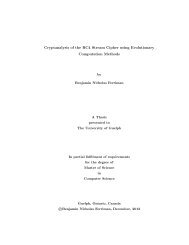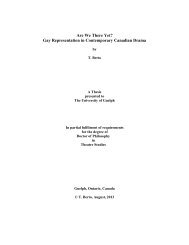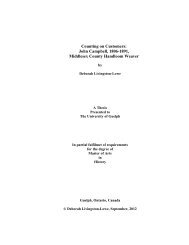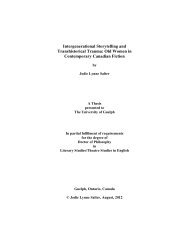THESIS - ROC CH ... - FINAL - resubmission.pdf - University of Guelph
THESIS - ROC CH ... - FINAL - resubmission.pdf - University of Guelph
THESIS - ROC CH ... - FINAL - resubmission.pdf - University of Guelph
You also want an ePaper? Increase the reach of your titles
YUMPU automatically turns print PDFs into web optimized ePapers that Google loves.
a peak at 22.6° is representative <strong>of</strong> the cellulose I form (Alemdar and Sain 2008; Chen et al.<br />
2011; Jonoobi et al. 2009; Segal et al. 1959). The incongruity with current trends arises with the<br />
crystallinity estimates whereby an opposite trend was observed. Using the method described<br />
by Segal et al. (1959), the estimated crystallinity values for raw SF, acid, alkaline 2, and SMF<br />
were 38.3%, 18.4%, 18.2%, and 13.5% respectively. Through each successive extraction step,<br />
the relative crystallinity decreased. This might indicate that for a given sample size, crystalline<br />
regions are converting to amorphous materials through each treatment. Even if amorphous<br />
fractions (lignin, hemicellulose, and pectin) were not successfully digested, the relative<br />
crystalline to amorphous material should be constant. As such, this decrease suggests the<br />
process is converting the crystalline regions to amorphous. Alternatively, it could be that<br />
crystalline fractions were washed away through the filtration process. This could be attributed to<br />
the SNF fibers released after the acid hydrolysis treatment. The SNF fibers were found to be<br />
crystalline due to the sharp peaks seen at 2Ɵ = 21.38, 27.8 and 29.16°. However, these peaks<br />
do not correlate to cellulose possibly due to the presence <strong>of</strong> pectin or hemicelluloses as<br />
suggested in the FTIR analysis. In addition, this does not explain the much more noticeable<br />
decrease in crystallinity found after mechanical treatment since filtration was not applied.<br />
Consequently, crystalline regions within the specific soy fibers obtained may be weak in<br />
comparison to the other fibers using a similar extraction process (Alemdar and Sain 2008; Sain<br />
and Oksman 2006; Wang and Sain 2007a; Wang and Sain 2007b). The chemi-mechanical<br />
process applied could be too harsh which broke down crystalline regions revealing higher<br />
concentrations <strong>of</strong> amorphous material within the samples. Process optimization will need to be<br />
tailored for different plant sources so that individualization for crystalline fibers can be<br />
maximized.<br />
61

















